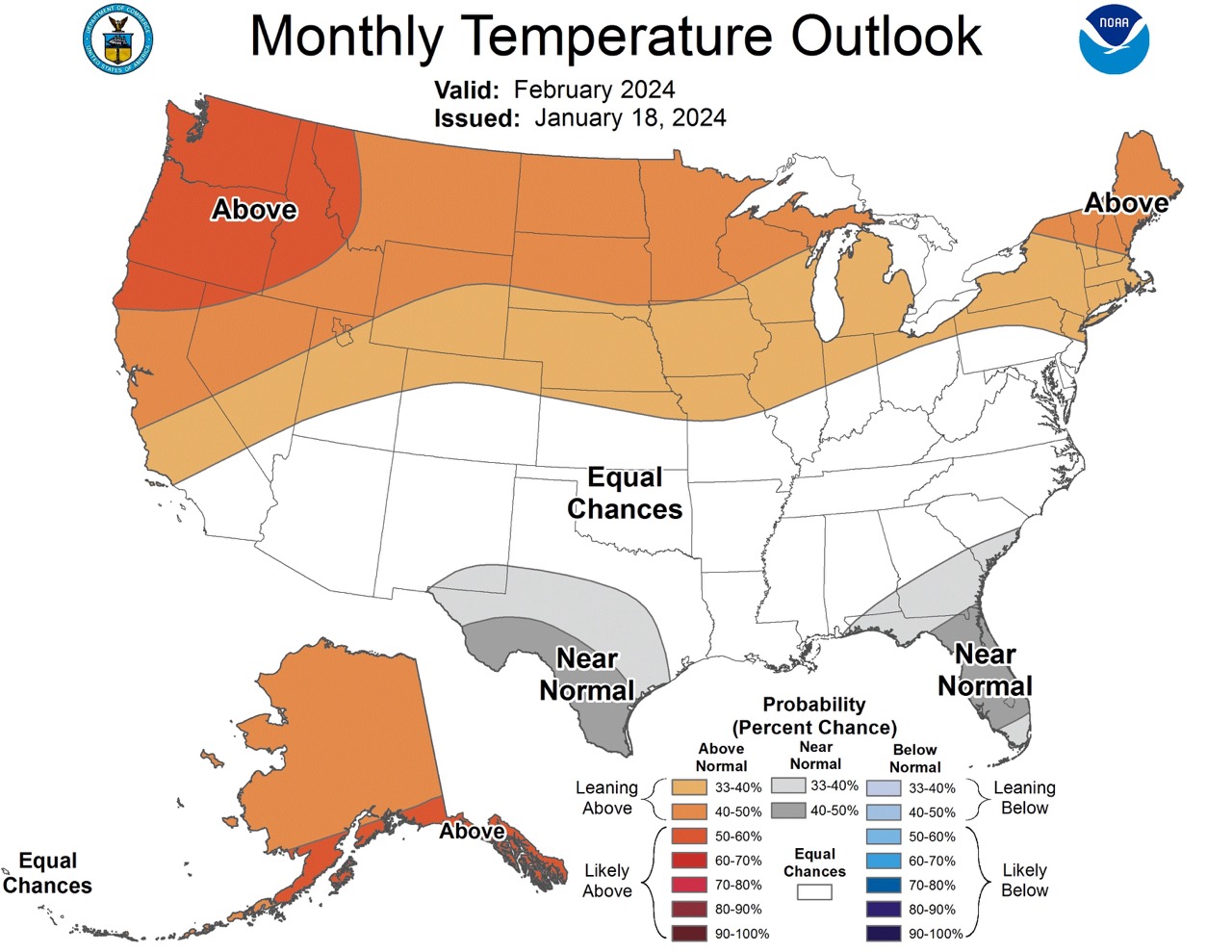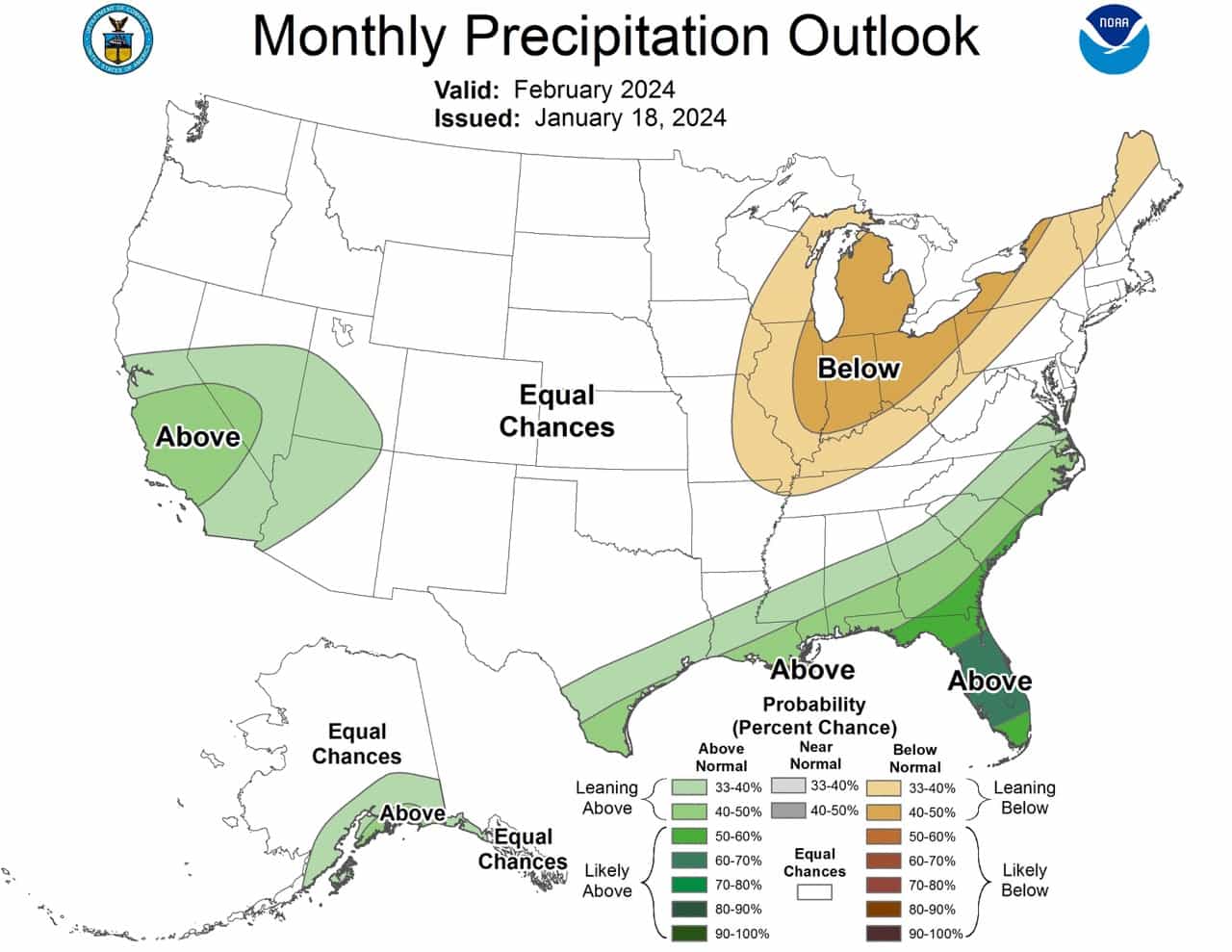
The NOAA recently released its outlook for February. For skiers or those seeking snow, the above-normal precipitation in regions like California, Nevada, Utah, and Arizona might be favorable for skiing conditions, especially in higher altitudes where temperatures remain cold enough for snow. However, the warmer temperatures in the Pacific Northwest and Alaska might limit snowfall or lead to faster melting. The below-normal precipitation in the Northeast and Great Lakes regions might mean less snowfall than usual in these traditionally snowy areas.
Below is an AI generated simplified summary, and also the full discussion from the NOAA for those who understand meteorological language.
Alaska
- Temperature: Above normal temperatures expected over all of Alaska, with higher chances for the south coast and Southeast Alaska.
- Precipitation: Above normal precipitation is likely for the south coast of Mainland Alaska and the northern Alaska Panhandle.
Pacific Northwest (U.S.)
- Temperature: High probability of above normal temperatures, especially in the Pacific Northwest.
California, Nevada, Utah, Arizona
- Temperature: Not specifically mentioned, but these regions often follow trends similar to the Pacific Northwest.
- Precipitation: Above normal precipitation is favored, particularly in Central and Southern California, extending northeastward into parts of Nevada, Utah, and Arizona.
Southeastern U.S. (Including Florida)
- Temperature: Enhanced probabilities of near-normal temperatures in parts of the Southeast.
- Precipitation: Above normal precipitation is likely, especially in the Gulf Coast and Florida Peninsula.
Central Mississippi Valley, Ohio Valley, Eastern Great Lakes, Northern New England
- Precipitation: Below normal precipitation is favored in these regions.
General Observations
- The forecast is largely influenced by a strong El Niño pattern, which typically affects temperature and precipitation patterns across North America.
- The forecast also considers various models and factors like sea surface temperature anomalies, wind patterns, and recent climate trends.

Below is the full discussion from the NOAA:
30-DAY OUTLOOK DISCUSSION FOR FEBRUARY 2024 The February 2024 monthly temperature and precipitation outlooks are made with strong current El Niño climate conditions. The most recent weekly and seasonal Niño 3.4 sea surface temperature (SST) anomalies are both at +1.9 degrees Celsius. SST anomalies over the central and east-central equatorial Pacific Ocean have remained steady over the last month, while positive SST anomalies over the far eastern equatorial Pacific have weakened slightly. In recent weeks, lower level wind anomalies at 850 hPa were westerly over the east-central equatorial Pacific Ocean, while upper level wind anomalies at 200 hPa were easterly over the east-central and eastern equatorial Pacific Ocean. Negative outgoing longwave radiation (OLR) anomalies are present near the Date Line and north of the equator over the eastern Pacific Ocean, indicating anomalously enhanced convection. These ocean and atmosphere conditions indicate that the ongoing strong El Niño is well coupled to the atmosphere. El Niño remains a primary driver of temperature and precipitation patterns over North America in the near future and in the February temperature and precipitation outlooks. On subseasonal timescales, the Madden Julian Oscillation (MJO) is active in phase 4 with enhanced convection over the Maritime Continent, with dynamical model forecasts indicating that the MJO will propagate eastward into the western Pacific in the next couple weeks. Lagged composites indicate that this active MJO would increase temperatures over the eastern United States in the next couple weeks, before returning to potentially cooler temperatures, especially over the Northeast, in early February. Impacts of the MJO were generally only considered in the February monthly outlook through dynamical model forecasts for the week 3-4 period that overlap with the first half of February. The February temperature and precipitation outlooks were based primarily on a skill-weighted consolidation of dynamical model forecasts and a combined consolidation of the statistical and dynamical model forecasts. Dynamical model forecasts for the month of February are from the North America Multimodel Ensemble (NMME). In addition, the full consolidation includes a consolidation of the statistical models: the Canonical Correlation Analysis (CCA), the Constructed Analog (CA), and an ENSO OCN tool, that combines the impact of ENSO, based on the CPC SST consolidation predicted median Niño 3.4 SST anomaly, with the Optimum Climate Normal (OCN) representing decadal trends . Daily initialized forecasts from the NCEP CFSv2 dynamical model, the most recent ECMWF and GEFS dynamical model forecasts for the week 3-4 period that overlaps the beginning of the month of February, and a statistical multivariate linear regression (MLR) forecast for the first half of February using the current Niño 3.4 and MJO indices as predictors, were also considered. Recent boundary conditions, including coastal SSTs, snow cover anomalies, and soil moisture anomalies, were additional factors considered. The February temperature outlook favors above normal temperatures over all of Alaska, consistent with dynamical model guidance and the monthly temperature consolidation. Above normal temperatures are more likely for the south coast of Mainland Alaska and Southeast Alaska, consistent with canonical El Niño impacts. Above normal temperatures are favored across the northern tier of the contiguous U.S. (CONUS), supported by the consolidation of statistical and dynamical forecast tools. Probabilities for above normal temperatures exceed 50 percent over the Pacific Northwest, due to strong signals in the NMME consolidation. Equal chances (EC) of below, near and above normal temperatures are indicated in the February outlook across much of the southern tier of the CONUS, due to conflicting signals from El Niño impacts and dynamical models . The outlook indicates enhanced probabilities of near-normal temperatures for parts of southeastern New Mexico, most of southern Texas, and for parts of the Southeast, consistent with the consolidation forecast and NMME probabilities. For the Southeast, decadal temperature trends are positive, while negative temperature anomalies are correlated with El Niño conditions. The February precipitation outlook favors above normal precipitation for much of the south coast of Mainland Alaska and the northern Alaska Panhandle, supported primarily by dynamical model forecasts from the NMME and correlation of seasonal precipitation to Niño 3.4 SST anomalies. Above normal precipitation is favored from Central and Southern California northeastward into parts of Nevada, Utah and Arizona, consistent with canonical El Niño impacts, dynamical model forecasts from CFSv2 for February, and dynamical model forecasts from the ECMWF and GEFS models for the first half of February. Negative decadal precipitation trends damp probabilities for above normal precipitation over this region. Above normal precipitation is also favored along the Gulf Coast and likely for parts of the Southeast, including the Florida Peninsula, where correlations of precipitation and the Niño 3.4 SST index are greatest. Below normal precipitation is favored from the Central Mississippi Valley, across the Ohio Valley, the eastern Great Lakes region, and over northern areas of New England, consistent with the CFSv2 model forecasts for February, and ECMWF and GEFS model forecasts for the first half of February.